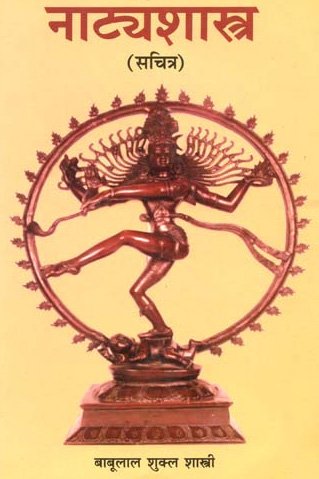Bibhatsarasa, Bibhatsa-rasa, Bībhatsarasa: 4 definitions
Introduction:
Bibhatsarasa means something in Hinduism, Sanskrit. If you want to know the exact meaning, history, etymology or English translation of this term then check out the descriptions on this page. Add your comment or reference to a book if you want to contribute to this summary article.
In Hinduism
Natyashastra (theatrics and dramaturgy)
Source: Wisdom Library: Nāṭya-śāstraBībhatsarasa (बीभत्सरस) refers to the “odious sentiment” used in dramatic performance (nāṭya). It is a Sanskrit compound composed of the words of bībhatsa (odious) and rasa (‘sentiment’). This sentiment is produced from a combination of determinants, consequents and complementary psychological states.
Source: Shodhganga: Elements of Art and Architecture in the Trtiyakhanda of the Visnudharmottarapurana (natya)Bībhatsarasa (बीभत्सरस) or simply Bībhatsa refers to the “odious sentiment” and represents one of the nine kinds of Rasa (“soul of Drama”), according to the Viṣṇudharmottarapurāṇa, an ancient Sanskrit text which (being encyclopedic in nature) deals with a variety of cultural topics such as arts, architecture, music, grammar and astronomy.—According to the Viṣṇudharmottarapurāṇa, the sentiment of bībhatsa arises from jugupsā i.e., disgusting sight and it is showed by shaking of nose. The Nāṭyaśāstra agrees on it and accepts jugupsā as the sthāyibhāva of bībhatsarasa. According to the Viṣṇudharmottarapurāṇa, Nīla i.e., blue is the colour and Mahākāla is the god of this sentiment. Bharata says that bībhatsarasa is to be represented through some activities such as stopping the movements of the limbs, narrowing down the mouth, vomiting, spitting, shaking of limbs in disgust etc.

Natyashastra (नाट्यशास्त्र, nāṭyaśāstra) refers to both the ancient Indian tradition (shastra) of performing arts, (natya—theatrics, drama, dance, music), as well as the name of a Sanskrit work dealing with these subjects. It also teaches the rules for composing Dramatic plays (nataka), construction and performance of Theater, and Poetic works (kavya).
Kavyashastra (science of poetry)
Source: Shodhganga: The Kavyavilasa of Ciranjiva Bhattacarya (kavyashastra)Bībhatsarasa (बीभत्सरस) refers to the “odious sentiment” or the “sentiment of disgustful” as defined by Cirañjīva Bhaṭṭācārya (fl. 17th century).—Cirañjīva says the basic feeling of bībhatsa-rasa is disgustful and it is generated by excitants (vibhāva) like sight of unwanted ugly things or events etc., ensuants (anubhāva) like spitting etc. and variants like infatuation or illusion etc. Though Cirañjīva has not said anything about the varieties of bībhatsa-rasa, Bharata, the author of Nāṭyaśāstra, has mentioned, three kinds of bībhatsa. These are—kṣobhaja, śuddha and udvegī.
Example of the sentiment of disgustful (bībhatsa-rasa):—
iyaṃ vyādhadārā vikārānupetā mṛgāntrālitantrā sakaṅkālamālā |
ativyāttavaktrā diśi kṣiptanetrā samutkṛtya māṃsaṃ piśācīva bhuṅkte ||“This wife of the fowler with deviated state of mind, whose garment is tied with entrails of beasts, who is adorned with the garland of bones; whose mouth is extremely expanded, whose eyes are distracted in different directions is eating the flesh after scratching like a female goblin”.
Notes: In this verse the wife of the fowler is the excitant, her eating of flesh after scratching is ensuant. Her irascibility (ugratā) is the variant. These moods being combined gives rise to the manifestation of the sentiment of disgustful.

Kavyashastra (काव्यशास्त्र, kāvyaśāstra) refers to the ancient Indian tradition of poetry (kavya). Canonical literature (shastra) of the includes encyclopedic manuals dealing with prosody, rhetoric and various other guidelines serving to teach the poet how to compose literature.
Languages of India and abroad
Kannada-English dictionary
Source: Alar: Kannada-English corpusBībhatsarasa (ಬೀಭತ್ಸರಸ):—[noun] = ಬೀಭತ್ಸ [bibhatsa]2 - 3.
Kannada is a Dravidian language (as opposed to the Indo-European language family) mainly spoken in the southwestern region of India.
See also (Relevant definitions)
Partial matches: Bibhatsa, Rasa, Raca.
Full-text: Bibhatsa, Odious, Kshobhaja, Shuddha, Udvegin, Udvegi, Vaikritya.
Relevant text
Search found 12 books and stories containing Bibhatsarasa, Bibhatsa-rasa, Bībhatsa-rasa, Bībhatsarasa; (plurals include: Bibhatsarasas, rasas, Bībhatsarasas). You can also click to the full overview containing English textual excerpts. Below are direct links for the most relevant articles:
Malatimadhava (study) (by Jintu Moni Dutta)
Literary Study (Conclusion) < [Chapter 2 - Literary Study of the Mālatīmādhava]
Part 1.3f - Bībhatsa Rasa (The Odious Sentiment): < [Chapter 2 - Literary Study of the Mālatīmādhava]
Part 4.3b - Ojas Guṇa (Floridity) < [Chapter 2 - Literary Study of the Mālatīmādhava]
Sahitya-kaumudi by Baladeva Vidyabhushana (by Gaurapada Dāsa)
Text 7.162 < [Chapter 7 - Literary Faults]
Text 8.9 < [Chapter 8 - Literary Qualities]
Text 4.37 < [Chapter 4 - First-rate Poetry]
Bhakti-rasamrta-sindhu (by Śrīla Rūpa Gosvāmī)
Verse 4.8.22 < [Part 8 - Compatible & Incompatible Mellows (maitrī-vaira-sthiti)]
Verse 4.8.14 < [Part 8 - Compatible & Incompatible Mellows (maitrī-vaira-sthiti)]
Verse 4.8.61 < [Part 8 - Compatible & Incompatible Mellows (maitrī-vaira-sthiti)]
Dramaturgy in the Venisamhara (by Debi Prasad Namasudra)
Bībhatsa Rasa (Disgust) < [Chapter 4 - Dramaturgy in Veṇīsaṃhāra]
Bībhatsa Rasa (disgust) < [Chapter 4 - Dramaturgy in Veṇīsaṃhāra]
Rasa-carvaṇa (The relish of Rasa) < [Chapter 4 - Dramaturgy in Veṇīsaṃhāra]
Mudrarakshasa (literary study) (by Antara Chakravarty)
3.7. Use of Bībhatsarasa (odius sentiment) < [Chapter 2 - Delineation of Rasa in Mudrārākṣasa]
4. Conclusion < [Chapter 2 - Delineation of Rasa in Mudrārākṣasa]
Jivanandana of Anandaraya Makhin (Study) (by G. D. Jayalakshmi)
Analysis of Bībhatsa-rasa < [Chapter 6 - Dramatic aspects of the Jīvanandana Nāṭaka]